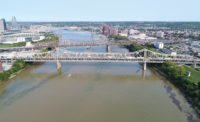The Biden administration has announced plans to spend $1 billion in Infrastructure Investment and Jobs Act (IIJA) funds to accelerate cleanups and restoration at environmentally degraded sites in the Great Lakes region, which, officials say, will allow most of the key projects to be completed by 2030.
In announcing the program on Feb. 17, the U.S. Environmental Protection Agency said the IIJA money—combined with other Great Lakes Restoration Initiative appropriations and aid from other sources—will enable it to complete work at 22 of the 25 remaining sites designated as areas of concern (AOCs) by 2030.
They include the Grand Calumet River in Indiana, the Cuyahoga River in Ohio and the Fox River in Wisconsin.
An independent commission in 1987 designated 31 AOCs within the U.S. and 12 in Canada. But cleaning them up moved at a glacial pace until the Great Lakes Restoration Initiative was established in 2010, and with it, more funding.
Since then, more progress on restoring the Great Lakes has been made, but it has still been slow, senior administration officials said during a Feb. 16 background call with reporters.
“This level of progress would have been inconceivable just a few years ago," one official said. "Thanks to the bipartisan infrastructure law funding, we have the financial resources to make this a reality."
The White House says it hopes to be able to remove 16 of the sites from the list, bringing the total of delisted AOCs to 22 between now and 2030.
The injection of additional funding will be particularly helpful at sites where extensive sediment remediation is needed, the officials said on the call.
EPA estimates the cost to complete all of the needed work at nearly $2 billion.
“Several of the big, complex areas of concern, like Milwaukee and Detroit, will cost over $100 million each,” one of the officials said.
Moreover, after remediation is complete, monitoring to ensure that all of the criteria that are necessary to deem the site environmentally healthy are met must be done for a certain period of time before a site can be delisted.
Targeting the Cuyahoga
AOCs along the Cuyahoga River, which helped to launch the environmental movement in the U.S. when it caught fire in the 1970s, are among the sites expected to be restored by 2030, according to EPA.
Two major contaminated sediment remediation projects on the Cuyahoga are in the design phase, and involve cleaning sediment contaminated with PCBs, pesticides, heavy metals, oil and grease, as well as Polycyclic aromatic hydrocarbons (PAHs). EPA and state and local agencies will share in the costs of those projects. Construction could begin at both projects as early as 2023, EPA says.
How the Great Lakes Funding Flows
The Great Lakes Restoration Initiative funds are appropriated to EPA, when then provides funds to other federal agencies, including the Fish and Wildlife Service and Army Corps of Engineers.
Those agencies, and EPA itself, use the dollars to fund restoration projects. The agencies post notices of funding opportunities, including notices of competitive awards.
EPA and the other federal agencies can undertake projects themselves or fund projects that are overseen by states, localities, tribes, universities and nongovernmental organizations.





